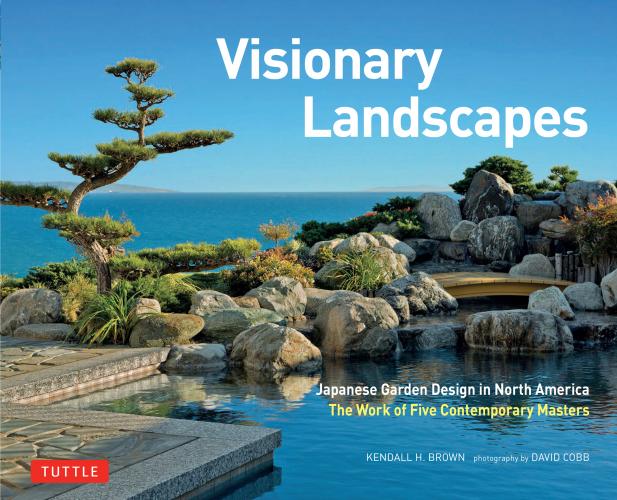Hoeschler Residence, St. Paul, MN.
B Residence, Darien, CT.
B Residence, Darien, CT.
Visionary
Landscapes
Japanese Garden Design in North America
The Work of Five Contemporary Masters
KENDALL H. BROWN
PHOTOGRAPHY BY DAVID COBB
TUTTLE Publishing
Tokyo | Rutland, Vermont | Singapore
contents
Traditions of Change: Japanese-Style Gardens Today
CHAPTER 1
Hōichi Kurisu
Gardens of Vision—Lives of Insight: The Healing Worlds of Hōichi Kurisu
A Life in Gardens
Repairing the World: The Samaritan Lebanon Community Hospital Garden
Eden on the Fourteenth Floor: A Garden Grows in Downtown Chicago
The Journey Begins: The DeVos Japanese Garden at the Frederik Meijer Gardens & Sculpture Park
CHAPTER 2
Takeo Uesugi
Joy and Light: The Spiritual Gardens of Takeo Uesugi
The Accidental Garden Builder
Confluence in Three Dimensions: The Grand Hyatt Atlanta
Light and Space by the Pacific: The Uyesugi Residence in Malibu
Following the Path: The San Diego Friendship Garden
CHAPTER 3
David Slawson
The Nature of Gardens: David Slawson’s Sense of Place
Finding Self, Evoking Landscape
Sage Mountain Sky: The Garden at the Aspen Institute
Landscapes for Evolved Living: Minnesota’s North Shore at the Hoeschler Residence
Integrating Life and Landscape: An Ozark Glen at the Heinzelmann Residence
Mountain High: The Floating Cloud Bridge at Garvan Woodland Gardens
CHAPTER 4
Shin Abe
Modernist Space: Shin Abe’s Dynamically Balanced Gardens
Creating Balance, Building a Practice
Reverberations: The United Nations’ Peace Bell Courtyard
An Intimate Journey: The Garden Path at a Private Washington, DC Residence
Inspiration for Reflection: Restorative Gardens at the Stoner Residence
On the Edge: Sculpting Water at the EF Building II, Cambridge, MA
CHAPTER 5
Marc Peter Keane
Garden Artistry: Marc Peter Keane’s Reflections on Nature and Gardens
The “Lives” of the Eminent Garden Artist
Gardens as Journeys: The B Residence, Darien, CT
Forest-Ocean Garden: The Blum Residence, Irvington, NY
Dream Islands: The Z Residence, Stone Ridge, NY
At Tiger Glen Garden: Herbert F. Johnson Museum of Art, Cornell University
Endnotes
Acknowledgments
Select Bibliography
Private residence, Washington, DC.
DeVos Japanese Garden, Grand Rapids, MI.
Morikami Japanese Gardens, Delray Beach, FL.
Tiger Glen Garden, Ithaca, NY.
TRADITIONS OF CHANGE:
JAPANESE-STYLE GARDENS TODAY
Gardens have flourished in Japan for fifteen centuries. Japanese gardens have been created around the world for only about 150 years, yet they are now more common outside Japan than in it. For non-Japanese, these gardens often exist as dreams of elsewhere and constructions of otherness. As microcosms of an idealized Japanese tradition, the landscapes can provide a compelling alternative to the banality of the here and now. Japanese gardens also serve as a kind of road home, a way of connecting with idealizations of nature that restore us mentally and physically. They are a cultural interpretation of nature refined into compelling and inspiring design forms transportable across time and space.
In the 21st century, Japanese gardens may well be considered a universal art. Like classical music, they are a set of forms and principles nurtured over time in a distinct place, then embraced and adapted so widely and deeply as to constitute an expressive language likely meaningful everywhere and available to anyone. Links with their birth culture, once strong, have become weaker as these garden styles accumulate identities and functions that may relate to Japan only tangentially. As such, it makes sense to call them Japanese-style gardens, acknowledging gardens based on adaptable values rather than gardens made in Japan or about Japan.
How and why have Japanese-style gardens grown into this remarkable, universal phenomenon? Beginning at world fairs in the 1870s in Europe and North America, Japanese entrepreneurs and officials built gardens as captivating settings for Japanese cultural and trade displays. At the same time, Euro-American tourists to Japan were filling their itineraries to the “flowery kingdom” with visits to gardens at temples, villas, restaurants and curio shops. Soon gardens became a kind of export commodity. Returning home, well-healed globetrotters commissioned their own Japanese garden. Aided by Japanese immigrants eager for work and abetted by Josiah Conder’s popular primer, Landscape Gardening in Japan (1893), gardens graced grand country homes and middle-class yards. Entrepreneurs fashioned commercial tea gardens where people gathered for leisure. City fathers, anxious to promote civic culture and beauty, adorned their parks with Japanese gardens.
In the Cold War era after World War II, the desire to re-establish bonds with Japan instigated a fresh era of Western interest in Japanese culture. This led to the refashioning of Japanese gardens as symbols of sophisticated beauty and international cooperation. Whether naturalistic gardens that abjured the trappings of pre-war exoticism, or “dry landscape” stone gardens that spoke the new universal
